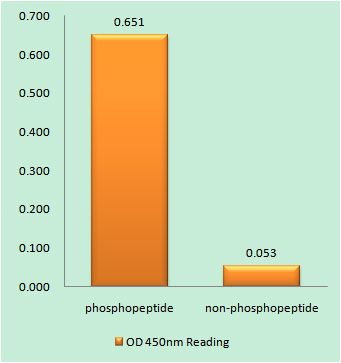Phospho AP-1 (Y170) Cell-Based Colorimetric ELISA Kit
- Catalog No.:KA1064C
- Applications:ELISA
- Reactivity:Human;Mouse;Rat
- Gene Name:
- JUN
- Protein Name:
- Transcription factor AP-1;jun;c-jun;AP-1
- Human Gene Id:
- 3725
- Human Swiss Prot No:
- P05412
- Mouse Swiss Prot No:
- P05627
- Rat Swiss Prot No:
- P17325
- Storage Stability:
- 2-8°C/6 months
- Other Name:
- Transcription factor AP-1 (Activator protein 1) (AP1) (Proto-oncogene c-Jun) (V-jun avian sarcoma virus 17 oncogene homolog) (p39)
- Detection Method:
- Colorimetric
- Background:
- function:Transcription factor that recognizes and binds to the enhancer heptamer motif 5'-TGA[CG]TCA-3'.,PTM:Phosphorylation enhances the transcriptional activity. Phosphorylated by PRKDC.,similarity:Belongs to the bZIP family.,similarity:Belongs to the bZIP family. Jun subfamily.,similarity:Contains 1 bZIP domain.,subunit:Heterodimer with either FOS or BATF3. Interacts with HIVEP3 (By similarity). Interacts with SMAD3/SMAD4 heterodimers. Interacts with MYBBP1A, SPIB and TCF20. Interacts with COPS5; indirectly leading to its phosphorylation. Interacts with DSIPI; this interaction inhibits the binding of active AP1 to its target DNA.,
- Function:
- protein import into nucleus, translocation, response to reactive oxygen species, angiogenesis, blood vessel development, release of cytochrome c from mitochondria, regulation of protein amino acid phosphorylation, negative regulation of protein amino acid phosphorylation, vasculature development, response to molecule of bacterial origin,regulation of myeloid leukocyte differentiation, positive regulation of myeloid leukocyte differentiation, regulation of DNA replication, transcription, regulation of transcription, DNA-dependent, regulation of transcription from RNA polymerase II promoter, protein targeting, protein import into nucleus, cellular ion homeostasis, intracellular protein transport, nucleocytoplasmic transport, apoptosis, response to oxidative stress, mitochondrion organization, cell surface receptor linked signal transduction, enzyme linked receptor protein signaling pathway
- Subcellular Location:
- Nucleus.
- Expression:
- Expressed in the developing and adult prostate and prostate cancer cells.
- June 19-2018
- WESTERN IMMUNOBLOTTING PROTOCOL
- June 19-2018
- IMMUNOHISTOCHEMISTRY-PARAFFIN PROTOCOL
- June 19-2018
- IMMUNOFLUORESCENCE PROTOCOL
- September 08-2020
- FLOW-CYTOMEYRT-PROTOCOL
- May 20-2022
- Cell-Based ELISA│解您多样本WB检测之困扰
- July 13-2018
- CELL-BASED-ELISA-PROTOCOL-FOR-ACETYL-PROTEIN
- July 13-2018
- CELL-BASED-ELISA-PROTOCOL-FOR-PHOSPHO-PROTEIN
- July 13-2018
- Antibody-FAQs
-if-41.jpg)

